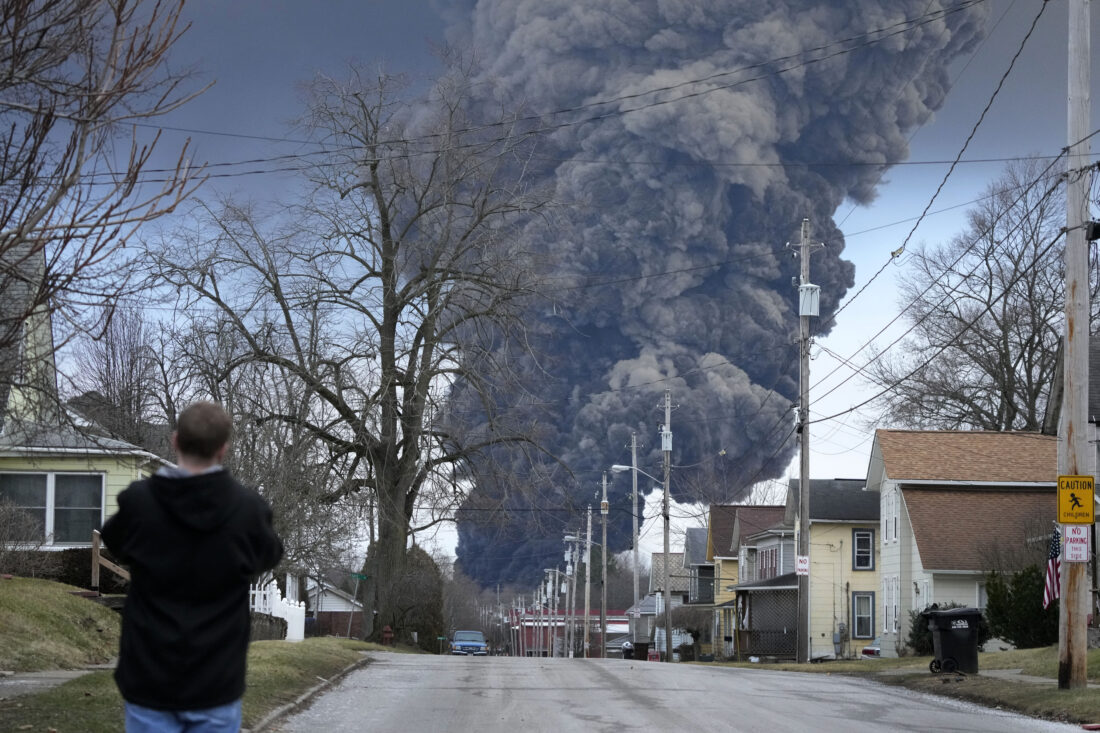Ohio Train Disaster: Persistent Toxic Chemicals Found In Buildings After Months

Table of Contents
The Extent of the Contamination
The Ohio train derailment released a cocktail of hazardous chemicals, including vinyl chloride, butyl acrylate, and ethylene glycol monobutyl ether. These substances are known to cause a range of acute and chronic health problems. The extent of the contamination is still unfolding, months after the initial accident.
Chemicals Found and Their Impact:
- Vinyl Chloride: A known carcinogen, linked to liver cancer, brain cancer, and other serious illnesses.
- Butyl Acrylate: Can cause skin, eye, and respiratory irritation; also linked to potential long-term health issues.
- Ethylene Glycol Monobutyl Ether: Causes eye, skin, and respiratory irritation, and can affect the nervous system.
The presence of these chemicals has been detected in various locations:
- Residential homes in East Palestine, particularly those located near the derailment site.
- Soil and water samples taken from areas surrounding the accident.
- Building materials themselves, suggesting deep penetration of the toxins.
Precise quantification of contamination levels is ongoing, with some areas showing elevated levels of these toxins in parts per million (ppm), exceeding safe limits. The persistence of these chemicals in soil, water, and building materials presents a significant challenge to effective remediation efforts. Testing methods used include soil sampling, water analysis, and air quality monitoring, with additional advanced techniques being employed to detect trace amounts of chemicals that may have permeated building structures.
Long-Term Health Impacts
Residents of East Palestine have reported a wide array of health problems since the derailment. The long-term consequences of exposure to this toxic chemical mixture remain a major concern.
Reported Symptoms and Illnesses:
- Headaches
- Nausea and vomiting
- Respiratory problems (coughing, shortness of breath)
- Skin irritations and rashes
- Eye irritation
While establishing a direct causal link between specific health problems and the chemical exposure is challenging, the high incidence of reported symptoms warrants serious attention. The number of individuals seeking medical attention for these ailments is significant and growing, raising urgent questions about long-term health risks. Several epidemiological studies are now underway to assess the long-term health effects on the affected population, with a particular focus on cancers and other chronic diseases.
Government Response and Accountability
The government's response to the Ohio train derailment has faced significant criticism. While cleanup efforts have been underway, concerns remain about their effectiveness and thoroughness.
Clean-up Efforts and Controversies:
- Initial cleanup focused primarily on controlled burns and immediate containment of the spilled chemicals. The long-term impact of these burn-off operations still requires careful assessment.
- Criticisms have focused on the perceived slow pace of the cleanup and the lack of transparency regarding the extent of the contamination.
- Legal actions against Norfolk Southern, the railway company responsible for the derailment, are anticipated, focusing on negligence and the cost of cleanup and remediation.
The Environmental Protection Agency (EPA) and other government agencies are involved, but the overall efficacy of their combined response remains a subject of ongoing debate. Concerns persist about the adequacy of environmental monitoring and the potential for long-term contamination that may not be adequately addressed by current remediation efforts.
Community Impact and Future Concerns
The Ohio train derailment has had a profound impact on the community of East Palestine, going far beyond the immediate environmental damage.
Economic and Social Effects:
- Job losses in industries reliant on clean water and healthy soil.
- Business closures resulting from decreased tourism and public confidence.
- Significant mental health challenges for residents facing uncertainty and fear about their health and future.
- Decreased property values, impacting the long-term financial well-being of residents.
The future of East Palestine depends heavily on the success of long-term remediation efforts, effective public health monitoring, and sustained community support. The need for comprehensive medical monitoring and mental health resources remains critical. Residents are rightly demanding long-term governmental support and financial assistance to address the multitude of economic and social challenges resulting from the disaster.
Conclusion
The Ohio train derailment's impact extends far beyond the initial event. The persistent presence of toxic chemicals in buildings months later underscores the gravity of this ongoing environmental and public health crisis. The long-term health effects remain uncertain, yet the reported symptoms and the need for extensive research and epidemiological studies are undeniable. The government's response, while ongoing, has faced criticism concerning speed, thoroughness, and transparency. The economic and social impact on East Palestine is devastating, demanding sustained support and accountability.
We must remain vigilant. The lingering threat posed by the Ohio train derailment aftermath necessitates continued monitoring, comprehensive remediation efforts, and a commitment to holding responsible parties accountable. Understanding the long-term effects of the Ohio chemical spill is crucial for preventing similar disasters and ensuring the health and wellbeing of affected communities. The Ohio toxic chemical contamination demands our ongoing attention and a concerted effort to ensure justice and long-term support for East Palestine. The ongoing situation necessitates immediate and sustained action to prevent future catastrophes and mitigate the impact of this devastating event.

Featured Posts
-
 100 Immigrants Found Detained During Underground Nightclub Raid Cnn
Apr 29, 2025
100 Immigrants Found Detained During Underground Nightclub Raid Cnn
Apr 29, 2025 -
 New Documentary Willie Nelson Celebrates The Life Of His King Roadie
Apr 29, 2025
New Documentary Willie Nelson Celebrates The Life Of His King Roadie
Apr 29, 2025 -
 Your Guide To Buying Capital Summertime Ball 2025 Tickets
Apr 29, 2025
Your Guide To Buying Capital Summertime Ball 2025 Tickets
Apr 29, 2025 -
 Open Thread February 16 2025 Discussion
Apr 29, 2025
Open Thread February 16 2025 Discussion
Apr 29, 2025 -
 Teens Reckless Act Rock Throwing Leads To Murder Conviction
Apr 29, 2025
Teens Reckless Act Rock Throwing Leads To Murder Conviction
Apr 29, 2025
Latest Posts
-
 Rising Wildfire Threat Uks Rarest Wildlife On The Brink Of Extinction
May 13, 2025
Rising Wildfire Threat Uks Rarest Wildlife On The Brink Of Extinction
May 13, 2025 -
 Is Bar Roma Worth The Hype A Blog To Toronto Review
May 13, 2025
Is Bar Roma Worth The Hype A Blog To Toronto Review
May 13, 2025 -
 The Impact Of Wildfires On The Uks Rarest And Most Endangered Species
May 13, 2025
The Impact Of Wildfires On The Uks Rarest And Most Endangered Species
May 13, 2025 -
 Bar Roma Your Guide To This Popular Toronto Bar Blog To
May 13, 2025
Bar Roma Your Guide To This Popular Toronto Bar Blog To
May 13, 2025 -
 Extinction Crisis Uk Wildfires Kill And Critically Endanger Rare Wildlife
May 13, 2025
Extinction Crisis Uk Wildfires Kill And Critically Endanger Rare Wildlife
May 13, 2025
